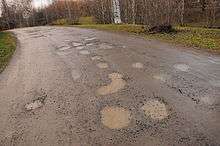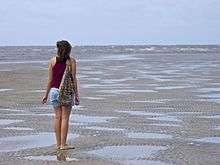Puddle

A puddle is a small accumulation of liquid, usually water, on a surface.[1] It can form either by pooling in a depression on the surface, or by surface tension upon a flat surface.
A puddle is generally shallow enough to walk through, and too small to support a boat or raft. Young children enjoy splashing in puddles, often while wearing wellington boots. Small wildlife may be attracted to puddles.
Natural puddles and wildlife


_-_363.jpg)

Puddles in natural landscapes and habitats, when not resulting from precipitation, can indicate the presence of a seep or spring. Small seasonal riparian plants, grasses, and wildflowers can germinate with the ephemeral "head start" of moisture provided by a puddle.
Small wildlife, such as birds and insects, can use puddles as a source of essential moisture or for bathing. Raised constructed puddles, bird baths, are a part of domestic and wildlife gardens as a garden ornament and "micro-habitat" restoration. Swallows use the damp loam which gathers in puddles as a form of cement to help to build their nests. Many butterfly species and some other insects, but particularly male butterflies, need puddles for nutrients they can contain, such as salts and amino acids. In a behaviour known as puddling they seek out the damp mud that can be found around the edge of the puddles.[2]
For some smaller forms of life, such as tadpoles or mosquito larvae, a puddle can form an entire habitat. Puddles that do not evaporate quickly can become standing water, which can become polluted by decaying organisms and are often home to breeding mosquitos, which can act as vectors for diseases such as malaria and, of more recent concern in certain areas of the world, West Nile Virus.
Puddles on roads
Puddles commonly form during rain, and can cause problems for transport. Due to the angle of the road, puddles tend to be forced by gravity to gather on the edges of the road. This can cause splashing as cars drive through the puddles, which causes water to be sprayed onto pedestrians on the pavement. Irresponsible drivers may do this deliberately, which, in some countries, can lead to prosecution for careless driving.[3]
Puddles commonly form in potholes in a dirt road, or in any other space with a shallow depression and dirt. In such cases, these are sometimes referred to as mud puddles, because mud tends to form in the bottoms, resulting in dirtied wheels or boots when disturbed.
In order to deal with puddles, roads and pavements are often built with a camber (technically called 'crowning'), being slightly convex in nature, to force puddles to drain into the gutter, which has storm drain grates to allow the water to drain into the sewers. In addition, some surfaces are made to be porous, allowing the water to drain through the surface to the aquifer below.
Physics
Due to the action of surface tension, small puddles can also form if a liquid is spilt on a level surface. Puddles like this are common on kitchen floors. Puddles tend to evaporate quickly due to the high surface-area-to-volume ratio and tend to be short lived. In cold conditions puddles can form patches of ice which are slippery and difficult to see and can be a hazard to road vehicles and pedestrians.
Children
Puddles are a source of recreation for children, who often like jumping in puddles as an "up-side" to rain.[4][5][6][7][8] A children's nursery rhyme records the story of Doctor Foster and his encounter with a puddle in Gloucester. Muddy puddles, and the pleasures of splashing mud in them, are a repeated theme in the children's animation Peppa Pig, to the extent of selling character-branded wellington boots.
Puddle thinking
It has been fashionable for millennia, and continues to be fashionable in some circles, to believe the Universe is designed for humans. Some critics of this view reject it as hubris or anthropocentrism and argue instead that through the process of evolution it is humans that have adapted to or been shaped by the Universe.[9][10][11] In his book The Salmon of Doubt, Douglas Adams satirizes the belief that the universe is designed for humans:[12]
imagine a puddle waking up one morning and thinking, 'This is an interesting world I find myself in, an interesting hole I find myself in, fits me rather neatly, doesn't it? In fact, it fits me staggeringly well, must have been made to have me in it!' This is such a powerful idea that as the sun rises in the sky and the air heats up and as, gradually, the puddle gets smaller and smaller, it's still frantically hanging on to the notion that everything's going to be all right, because this World was meant to have him in it, was built to have him in it; so the moment he disappears catches him rather by surprise.
History
When Walter Raleigh met Queen Elizabeth I, Raleigh is reputed to have thrown his coat over a muddy puddle to allow the Queen to cross without getting her feet wet as an act of chivalry.
Medieval legend spoke of one man who was desperate to find building materials for his house, so he stole cobblestones from the road surface. The remaining hole filled with water and a horseman who later walked through the 'puddle' actually found himself drowning. A similar legend, of a young boy drowning in a puddle that formed in a Pothole in a major street in the early years of Seattle, Washington, is told as part of the Seattle Underground Tour.
See also
References
- ↑ http://www.merriam-webster.com/dictionary/puddle
- ↑ Adler, P.H. and Pearson, D.L. (1982) "Why do male butterflies visit mud puddles?". Canadian Journal of Zoology, 60 (3): 322–325. doi:10.1139/z82-043
- ↑ Driver fined over puddle splash BBC News, 31 October 2005.
- ↑ Siu-Lan Tan (25 March 2014). "Splash! What Kids Discover in a Puddle". Psychology Today.
- ↑ Ranko Rajovic (24 May 2016). "Why Splashing in Mud Puddles Is Beneficial for Children". Novak Djokovic Foundation.
- ↑ Meredith Burton. "Play in a Puddle on a Rainy Day". National Association for the Education of Young Children.
- ↑ Catherine O'Dolan (6 August 2010). "The joys of jumping in puddles". Junior.
- ↑ Harriet Mallinson (12 May 2016). "How do you entertain a group of toddlers? Give them a puddle!". Daily Mail.
- ↑ Feinberg, Gerald and Shapiro,Robert (1993) "A Puddlian Fable" in Huchingson, Religion and the Natural Sciences, pp. 220–221.
- ↑ Williams, Robyn (18 February 2006). "The anthropic universe". The Science Show. ABC Radio National. Retrieved 19 November 2009.
- ↑ Redfern, Martin (24 December 1995). "Proofs of God in a photon". The Independent.
- ↑ Adams, Douglas (2002). The Salmon of Doubt: Hitchhiking the Galaxy One Last Time. Harmony Books. p. 131. Retrieved January 9, 2015.
Further reading
| Wikimedia Commons has media related to Puddles. |
- Adler PH (1982) "Soil and puddle visiting habits of moths" Journal of the Lepidopterists' Society, 36: 161–173.
- Allocco, Maria (1999) "Puddle of light" Phys. Teach. 37: 468.
- McLachlan A and Ladle R (2001) "Life in the puddle: behavioural and life-cycle adaptations in the Diptera of tropical rain pools" Biological Reviews, 76 (3): 377–388. doi:10.1017/S1464793101005723
- Royston, Angela (2005) Water: Let's Look at a Puddle Heinemann/Raintree. ISBN 978-1-4034-7685-2.
- Weiss, Peter (2004) "Piddly puddle peril: Little water pools foil road friction" Science News, 166(20): 308. doi:10.2307/4015763
